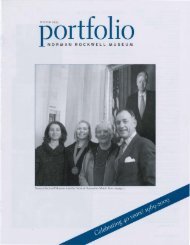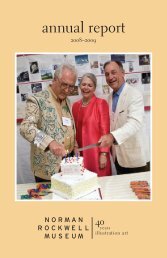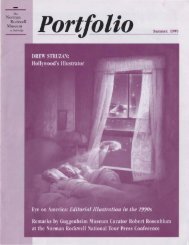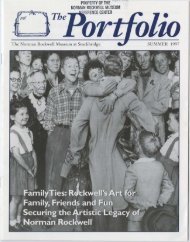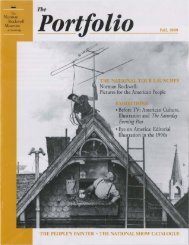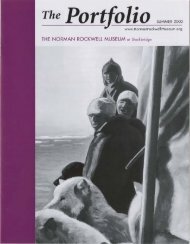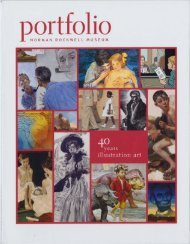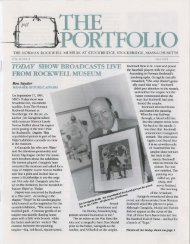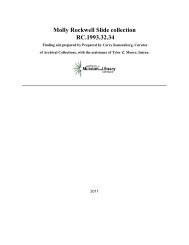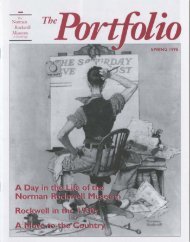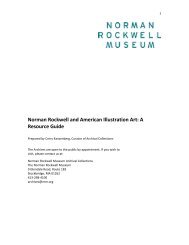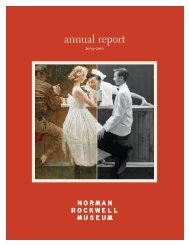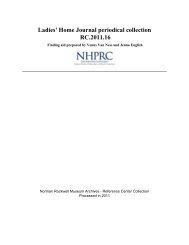Summer 1998 - Norman Rockwell Museum
Summer 1998 - Norman Rockwell Museum
Summer 1998 - Norman Rockwell Museum
You also want an ePaper? Increase the reach of your titles
YUMPU automatically turns print PDFs into web optimized ePapers that Google loves.
-T he<br />
<strong>Norman</strong><br />
<strong>Rockwell</strong><br />
<strong>Museum</strong><br />
at Stockbridge<br />
1
Five-Year Highlights-<br />
1993-<strong>1998</strong><br />
IT IS F1VE YEARS SINCE TIlE NEW NORMAN ROCKWELL<br />
<strong>Museum</strong> opened. Here are photographs from our<br />
scrapbooks of highlights in the museum galleries and<br />
scenes from our magnificent 36-acre landscape.<br />
Inside the Galleries<br />
<strong>Museum</strong> guide Roberta Wolf conducts a<br />
crowded and multi-generational tour in the<br />
Fitzpatrick gallery.<br />
This photograph<br />
of an amused trio<br />
looking at The<br />
Runaway proves<br />
that although<br />
guided tours are<br />
interesting and<br />
informative,<br />
visitors can enjoy<br />
a <strong>Rockwell</strong><br />
painting on their<br />
own.<br />
The <strong>Norman</strong> <strong>Rockwell</strong> <strong>Museum</strong><br />
Board of Trustees<br />
David L. Klausmeyer<br />
Bobbie Crosby<br />
Steven Spielberg<br />
Perri Petricca<br />
Roselle Kline Chartock<br />
William M. Bulger<br />
James A. Cunningham<br />
Daniel DuBois<br />
Joan SerVaas Durham<br />
Michelle Gillett<br />
Neil and Jane Golub<br />
Elaine S. Gunn<br />
James W.lreland<br />
Harvey Chet Krentzrnan<br />
Robert F. McDermott<br />
Trustees Emeriti<br />
President<br />
First Vice-President<br />
Second Vice-President<br />
Treasurer<br />
Clerk<br />
Timothy R. McLevish<br />
Thomas Patti<br />
Lincoln Russell<br />
Joseph M. Salvadore<br />
Mark Selkowitz<br />
Brian]. Quinn<br />
Aso Tavitian<br />
Laughran S.Vaber<br />
Lee Williams<br />
Jamie Williamson<br />
Lila Wilde Serle<br />
Jane P. Fitzpatrick<br />
John M. Deely, Jr. Norma G. Ogden<br />
Henry H. Williams,Jr.<br />
Laurie Norton Moffatt, Director<br />
Director Laurie Norton Moffatt stands<br />
with Judy Goffman Cutler and Laurence<br />
Cutler of the American Illustrators<br />
Gallery, New York City, at the<br />
November, 1995 opening of the exhibition<br />
Maxfield Parrish: A Retrospective.<br />
One sporting boy studies <strong>Norman</strong><br />
<strong>Rockwell</strong>'s Four Sporting Boys: Football,<br />
Basketball, Baseball, and Golf<br />
The Nonnan <strong>Rockwell</strong> <strong>Museum</strong> is funded in part<br />
by the Massachusetts Cultural Council, a state<br />
agency that supports public programs in the arts,<br />
humanities, and sciences.<br />
Ii<br />
MAssACHUSITfS UJLI UlUll.UJUI'K,IL<br />
The Portfolio<br />
Volume 15, Number 2, <strong>Summer</strong> <strong>1998</strong><br />
Cris Raymond, Editor<br />
Bea Snyder, Project Manager<br />
The Portfolio is published four times a year by<br />
The <strong>Norman</strong> <strong>Rockwell</strong> <strong>Museum</strong> at Stockbridge, Inc.,<br />
and is sent free to all members.<br />
Copyright © <strong>1998</strong> by The<br />
<strong>Norman</strong> <strong>Rockwell</strong> <strong>Museum</strong> at Stockbridge.<br />
All rights reserved.<br />
Cover: Sailing Out of Gloucester Harbor,<br />
1880, Winslow Homer, watercolor on<br />
paper. Courtesy of the Canajoharie<br />
. Library and Art Gallery.
Out on the<br />
Landscape<br />
Right, an unveiling moment at the <strong>Rockwell</strong><br />
<strong>Museum</strong> occurred in the fa ll of 1994 when Peter<br />
<strong>Rockwell</strong> removed the wraps from his eight-foot,<br />
5 1 /2 ton limestone sculpture, Grendel's Folly.<br />
"Please touch" is the idea behind<br />
this inviting bronze sculpture Three<br />
Tumblers by Peter <strong>Rockwell</strong>. For<br />
this scene, the piece could be<br />
renamed the Six Tumblers.<br />
Grand Opening, June 13, 1993 is a<br />
day to remember. At the opening<br />
ceremonies, <strong>Norman</strong> <strong>Rockwell</strong>'s<br />
three sons-Peter, Tom, and<br />
Jarvis-and then Board President<br />
Lila Berle with Althea <strong>Rockwell</strong>,<br />
<strong>Norman</strong>'s great granddaughter,<br />
plant a commemorative tree on<br />
the landscape.<br />
Far right, in this 1994 photograph,<br />
Joan SerVass Durham, President of<br />
Curtis Archives, and Lila Berle,<br />
then Board President of the<br />
<strong>Norman</strong> <strong>Rockwell</strong> <strong>Museum</strong>,<br />
proudly display the <strong>Rockwell</strong> stamp<br />
featuring Triple-Self Portrait.<br />
<strong>Summer</strong> visitors<br />
relax on the hillside<br />
near <strong>Norman</strong><br />
<strong>Rockwell</strong>'s studio.<br />
Briggs & Stratton,<br />
makers of engines<br />
for lawn equipment,<br />
named the <strong>Norman</strong><br />
<strong>Rockwell</strong> <strong>Museum</strong><br />
to their <strong>1998</strong> list of<br />
Ten Best Lawns in<br />
America.
4<br />
The Art of <strong>Norman</strong> <strong>Rockwell</strong><br />
Visits Japan<br />
Laurie Norton Moffatt, Director<br />
A bill-board size poster of Merry<br />
Christmas Grandma advertising tbe<br />
exhibition was prominently displayed<br />
in Tokyo on tbe side of tbe Isetan<br />
Company, Limited building.<br />
T<br />
HE NORMAN ROCKWELL<br />
<strong>Museum</strong> realized its<br />
most ambitious exhibition<br />
to date when, after more<br />
than ten years of planning, we<br />
sent Highlights from the Collection<br />
of the <strong>Norman</strong> <strong>Rockwell</strong> <strong>Museum</strong><br />
to Japan in December of1997.<br />
Our Board of Trustees took<br />
great pleasure to present to our<br />
Japanese friends an important<br />
exhibition from the museum's<br />
collection that reflected<br />
<strong>Rockwell</strong>'s observation of<br />
America. It was the first time<br />
that so many of the museum's<br />
most treasured works had<br />
traveled from their home in<br />
Stockbridge. We are especially<br />
appreciative of Masahiko<br />
Shibata, President of Brain<br />
Trust, Inc., the sponsor of the<br />
exhibition, for his long-time<br />
friendship and support of the<br />
museum and his efforts to bring<br />
this collection to Japan.<br />
Many details were involved in<br />
organizing an exhibition of this<br />
magnitude. In addition to<br />
selecting the paintings and<br />
writing the catalogue, there was<br />
the physical packing and shipping<br />
of the 63 paintings, 21<br />
drawings, tear sheets, and<br />
posters of the Four Freedoms.<br />
Some of <strong>Rockwell</strong>'s best-known<br />
works-Marriage License, The<br />
Runaway, Girl at the Mirror and<br />
Deadline-were included in the<br />
exhibition.<br />
Part of our mandate as a<br />
museum is to preserve and<br />
protect the collection entrusted<br />
to us. As in the case of any loan<br />
request, the individual works .<br />
were first examined by conservators<br />
from Williamstown Art<br />
Conservation Center and a<br />
determination was made as to<br />
whether they were able to<br />
withstand the risks of travel.<br />
Thus, all the pieces were assessed<br />
bearing in mind the<br />
journey to and from Japan and<br />
the changes of venue within that<br />
country. Before packing in<br />
Stockbridge and at every<br />
location, condition reports were<br />
done on each painting and<br />
drawing.<br />
The artwork, accompanied by<br />
our museum courIers, was<br />
crated and transported by<br />
F ortress/Fine Arts Express and<br />
Japan Airlines, an exhibition<br />
sponsor. The museum couriers<br />
accompanied every move<br />
between the museum sites in<br />
Japan.<br />
The opening evening in<br />
Tokyo was a gala reception<br />
attended by such notables as<br />
Peter J. Kovach, Counselor for<br />
Cultural Affairs at the Embassy<br />
of the United States; Masahiko<br />
Shibata, President of Brain<br />
Trust, Inc.; Mr. Yasuo<br />
Hatakeyama, Managing Director<br />
of Isetan Company Limited,<br />
Tokyo; and Takeshi<br />
Matsumoto, Director of the<br />
Chihiro Iwasaki <strong>Museum</strong> of<br />
Picture Books. Joining me as<br />
representatives from the<br />
<strong>Norman</strong> <strong>Rockwell</strong> <strong>Museum</strong><br />
were Board President David<br />
Klausmeyer and our museum<br />
couriers Linda Szekely, Assistant<br />
Curator, and Josephine<br />
Nieuwenhuis, <strong>Museum</strong> Project
5<br />
An elegant<br />
salesperson<br />
displays one of the<br />
<strong>Rockwell</strong> shopping<br />
bags that the<br />
Isetan Co. used for<br />
purchases.<br />
Above right, prior<br />
to installation,<br />
conservator<br />
Kikuko Iwai<br />
carefully repaired<br />
the frame on<br />
Cousin Reginald<br />
Spells Peloponnesus.<br />
Registrar. In Tokyo, the exhibition<br />
was attended by over 1,500<br />
people on the first day.<br />
The Japanese people have a<br />
great interest in the work of<br />
<strong>Norman</strong> <strong>Rockwell</strong>. Many of the<br />
foreign visitors to Stockbridge<br />
are from Japan. The universality<br />
of the themes depicted in<br />
<strong>Rockwell</strong>'s paintings-family,<br />
love, humor-cross all cultures<br />
and social strata. <strong>Rockwell</strong>'s eye<br />
for accuracy of detail and<br />
carefully balanced compositions<br />
are qualities that also are reflected<br />
in Japanese art. The<br />
Japanese people are interested in<br />
America, and the image of<br />
America that they know is the<br />
one created by <strong>Norman</strong><br />
<strong>Rockwell</strong>. It is interesting to<br />
observe that reproductions of<br />
the works of <strong>Norman</strong> <strong>Rockwell</strong><br />
have long been on display in<br />
popular restaurants and at<br />
airports in Japan. Quite possibly,<br />
the exhibition, Highlights from<br />
the Collection of the <strong>Norman</strong><br />
<strong>Rockwell</strong> <strong>Museum</strong>, will generate<br />
even more interest in both<br />
<strong>Rockwell</strong> and America.<br />
During the months that the<br />
exhibition was in Japan, December<br />
3rd to May 17th, it traveled<br />
to six cities-Tokyo, Nagoya,<br />
Chiba, Niigata, Osaka and<br />
Hiroshima. More than 100,000<br />
people viewed the exhibition<br />
during the tour. The length of<br />
the venues ranged from eighteen<br />
days in Niigata to one month in<br />
Chiba. In each city, the exhibition<br />
was accompanied by<br />
representatives from Brain<br />
Trust, Inc., and our own well<br />
traveled museum team who<br />
logged in many hours crossing<br />
the Pacific. In the five and a half<br />
months of the tour, it received<br />
great coverage in the national<br />
newspaper Yomiuri Shinbun. On<br />
April 18th, I presented opening<br />
remarks at the final venue, the<br />
Hiroshima <strong>Museum</strong> of Art,<br />
followed by a heartwarming<br />
reunion with my rotary International<br />
host families with whom I<br />
lived in 1994.<br />
The work involved in planning<br />
this exhibition was an interde-<br />
partmental effort here at the<br />
museum. While the major work<br />
came from our curatorial<br />
department, the promotion,<br />
public relations, and marketing<br />
departments were closely<br />
involved in promoting the<br />
exhibition. Posters in the<br />
Japanese subways, shopping<br />
bags, and many other articles<br />
promoted the exhibition. One of<br />
the most beautiful exhibitionrelated<br />
items is the catalogue,<br />
which contains some of the<br />
finest <strong>Norman</strong> <strong>Rockwell</strong> reproductions<br />
ever produced. It is<br />
proudly displayed<br />
and sold in our<br />
museum store.<br />
Lest anyone<br />
think that our<br />
walls were empty<br />
while part of the<br />
collection was in<br />
Japan, visitors<br />
who came to<br />
Stockbridge still<br />
had many important<br />
<strong>Rockwell</strong><br />
artworks to see. In<br />
addition, changing<br />
exhibitions<br />
featuring the<br />
works of other<br />
well-known<br />
illustrators were<br />
on display. J. C.<br />
Leyendecker: A<br />
Retrospective was one of our<br />
exhibitions that drew interested<br />
crowds while Highlights from the<br />
Collection was touring in Japan.<br />
Now that the exhibition in<br />
Japan has ended, we have many<br />
new and exciting exhibits in the<br />
works. We hope to see you here<br />
in Stockbridge, but if you<br />
cannot travel to the <strong>Norman</strong><br />
<strong>Rockwell</strong> <strong>Museum</strong>, stay tuned,<br />
for one day very soon we might<br />
just be coming to your neighborhood.
6<br />
A VISit from the<br />
Reverend Jesse Jackson<br />
ON MARCH 12TH, JESSE JACKSON CAME TO<br />
Berkshire County to speak before a group gathered<br />
for the J. Leo Dowd and Catherine Mellon Dowd<br />
Lecture series held at Monument Mountain High<br />
School in Great Barrington.<br />
The major theme of Jackson's talk was to honor<br />
Great Barrington's native son WE.B. DuBois. As<br />
Jackson said, before Martin Luther King, Adam<br />
Clayton Powell and Malcolm X, there was WE.B.<br />
DuBois. Writer, historian, and sociologist, Dubois<br />
was one of the founding fathers of the NAA CP and,<br />
in Jackson's words, the "spiritual master of<br />
America's conscience."<br />
The morning after the lecture, Jesse Jackson<br />
accepted Director Laurie Norton Moffatt'S invitation<br />
to visit the <strong>Norman</strong> <strong>Rockwell</strong> <strong>Museum</strong>.<br />
<strong>Museum</strong> board member Elaine Gunn accompanied<br />
Reverend Jackson on his visit here. What follows is<br />
her account of the memorable visit.<br />
l<br />
SSEJACKSON' AFRICAN<br />
American, rose from student<br />
protester to civil rights leader,<br />
from chairman of PUSH<br />
(People United to Save Humanity)<br />
to negotiator for the release<br />
of 48 Cuban and Cuban-American<br />
prisoners in 1987. His work<br />
also has taken him from being a<br />
candidate for president to<br />
becoming the head of the<br />
Rainbow Coalition. He came to<br />
Stockbridge to praise another<br />
black man, W.E.E. DuBois, who<br />
left a legacy to this country that<br />
is yet unrivaled.<br />
While in Berkshire County,<br />
Jackson found the time to praise<br />
yet another American icon,<br />
<strong>Norman</strong> <strong>Rockwell</strong>. "Jesse<br />
Jackson visits the <strong>Norman</strong><br />
<strong>Rockwell</strong> <strong>Museum</strong>," I never<br />
dreamed that I'd be saying those<br />
The Reverend Jesse Jackson with museum<br />
board member Elaine Gunn.<br />
Murder in Mississippi, oil on canvas,<br />
unpublished version of a story illustration<br />
for Look magazine article, June 29, 1965.<br />
words or writing this. Had you<br />
been here when the Reverend<br />
Jackson visited the museum for<br />
the first time, you couldn't help<br />
but wonder what his thoughts<br />
and feelings were as he stepped<br />
into the Mirror on America<br />
Gallery to view the intensely<br />
moving and painful images<br />
captured so vividly by N.R.-The<br />
Problem We All Live With and<br />
Murder in Mississippi.<br />
Reverend Jackson's demeanor<br />
seemed to change as he viewed<br />
these two paintings. He became<br />
contemplative and humble as he<br />
listened to the story behind<br />
these pieces and read the<br />
account of the three civil rights<br />
workers who were murdered in<br />
Philadelphia, Mississippi. I<br />
wondered if he was remembering<br />
those particular days, those dark<br />
days when the country was in<br />
much turmoil, and the future<br />
seemed so uncertain.<br />
As we moved through the<br />
galleries, Reverend Jackson's<br />
mood lifted. When he viewed the<br />
Four Freedom images, he seemed<br />
quite impressed with <strong>Rockwell</strong>'s<br />
rendering of these basic freedoms,<br />
and expressed an interest<br />
in having prints of these paintings.<br />
The Reverend Jackson<br />
complimented <strong>Norman</strong><br />
<strong>Rockwell</strong>'s contribution to the<br />
country and even compared<br />
<strong>Rockwell</strong>'s legacy to that of<br />
DuBois.<br />
Upon leaving here, Jackson<br />
remarked that he would like to<br />
return to the <strong>Norman</strong> <strong>Rockwell</strong><br />
<strong>Museum</strong> someday. Anytime,<br />
Reverend Jackson!
Upcoming<br />
Exhibitions<br />
In addition to the permanent collection of<br />
<strong>Rockwell</strong>'s work, the <strong>Norman</strong> <strong>Rockwell</strong> <strong>Museum</strong> is<br />
pleased to present the following exhibitions.<br />
june 6, <strong>1998</strong> to<br />
October 25, <strong>1998</strong><br />
Changes and<br />
Challenges:<br />
<strong>Rockwell</strong> in the<br />
1930s<br />
june 6, <strong>1998</strong> to<br />
October 25, <strong>1998</strong><br />
As the country entered<br />
the Depression,<br />
<strong>Rockwell</strong>'s own life<br />
was changed by<br />
remarriage, fatherhood<br />
and what he<br />
described as "artist's<br />
block." This exhibition<br />
contains oil<br />
paintings, drawings,<br />
and magazine tear<br />
sheets from the<br />
museum collections<br />
and loans from private<br />
and public collections.<br />
AI Hirschfeld's work for<br />
N ew York newspapers<br />
chronicled the<br />
summer playhouse<br />
scene with his<br />
signature style<br />
that combined long sweeping<br />
lines, intricate curves and<br />
extensive cross hatching. For the first<br />
time, these unique drawings will be brought<br />
together in an intimate exhibition that explores<br />
the work of this famous illustrator.<br />
© 1985 AI Hirschfeld<br />
Winslow Homer: Artist<br />
& Illustrator<br />
july 3, <strong>1998</strong> to August 3D, <strong>1998</strong><br />
Winslow Homer occupies a<br />
coveted place in the pantheon of<br />
American art. Best known for his<br />
oils and watercolors, Homer<br />
began his artistic career as a<br />
lithographer's apprentice. This<br />
exhibition, which highlights<br />
Homer's work as an illustrator,<br />
features rarely exhibited watercolors<br />
and woodcut illustrations.<br />
Exhibit sponsored by the Berkshire Eagle.<br />
Visual Solutions:<br />
Seven Illustrators and the<br />
Creative Process<br />
November 7, <strong>1998</strong> to May 31, 1999<br />
Come see the process of how<br />
illustrators do what they do so<br />
well. Visual Solutions is a<br />
window into the working<br />
lives of seven contemporary<br />
illustrators-Eric Carle,<br />
Diane and Leo Dillon,<br />
Wendell Minor, Mike Deas,<br />
Barbara Nessim, and C. F.<br />
Payne. Represented are<br />
paintings, drawings, collages and<br />
computer images from children's<br />
books, editorial illustration and<br />
book cover art.<br />
<strong>Norman</strong> <strong>Rockwell</strong>'s<br />
Saturday Evening Post<br />
Covers<br />
September 5, <strong>1998</strong> to<br />
january 24, 1999<br />
This complete presentation of<br />
the 322 covers that <strong>Rockwell</strong><br />
painted for The Saturday Evening<br />
Post from 1916 to 1963 chronicles<br />
everyday life in America as well as<br />
the social and political events of<br />
the decades.<br />
Made in Massachusetts<br />
March 13, 1999 to May 31, 1999<br />
The fabric of cultural life in<br />
Massachusetts is profoundly<br />
enriched by the presence of the<br />
many illustrators who live and<br />
work in the state. Made in Massachusetts<br />
will celebrate the work of<br />
those artists who actively and<br />
diligently provide a link to<br />
<strong>Rockwell</strong>'s profession as illustrator.<br />
<strong>Rockwell</strong> Can Travel to You!<br />
If you and members of your community<br />
are not able to come to<br />
Stockbridge, consider bringing<br />
someone from the <strong>Norman</strong><br />
<strong>Rockwell</strong> <strong>Museum</strong> to your area to<br />
give an informal talk on the work of<br />
America's famous illustrator. For a<br />
fee plus travel expenses, a museum<br />
staff member will come to your<br />
town with a special slide presentation<br />
on <strong>Rockwell</strong>'s work and life.<br />
This informative talk is a wonderful<br />
way to bring <strong>Rockwell</strong> into your<br />
community. Call 413-298-4100,<br />
extension 220 to plan your program.
Winslow Homer: Artist & Illustrator<br />
Wendy Lutz, Curatorial Intern<br />
The See-Saw,<br />
watercolor on<br />
paper, 1873.<br />
Courtesy of The<br />
Canajoharie<br />
Library and Art<br />
Gallery<br />
occupies a coveted<br />
W:INSLOWHOMER<br />
place in the pantheon<br />
of American art. A prolific artist<br />
of remarkable versatility,<br />
Homer's work spans over half a<br />
century. His oils and watercolors<br />
that hang in galleries across the<br />
nation and the world are the<br />
subject of exhaustive analysis,<br />
exhibition and critique. Yet<br />
Winslow Homer began his<br />
artistic career with a charcoal<br />
pencil, not a paintbrush. Indeed,<br />
nineteenth-century Americans<br />
first became acquainted with<br />
Winslow Homer as a freelance<br />
magazine illustrator. He created<br />
more than two hundred and fifty<br />
magazine illustrations and<br />
contributed to over a dozen<br />
magazines, most notably<br />
Harper's Weekly. Homer's<br />
popularity as an illustrator and<br />
his long-term association with<br />
Harper's have been compared to<br />
<strong>Norman</strong> <strong>Rockwell</strong> and The<br />
Saturday Evening Post. Winslow<br />
Homer's illustrations, which<br />
span three decades, are a fascinating<br />
barometer of the development<br />
of this artist and the<br />
American nation.<br />
Born in 1836, Winslow<br />
Homer grew up in Cambridge,<br />
Massachusetts during the days<br />
when the university town was<br />
rural and unfettered by the city<br />
of Boston. Perhaps because his<br />
mother was an amateur artist<br />
and his father was something of<br />
an adventurous business speculator,<br />
young "Win's" interest in<br />
sketching was actively encouraged<br />
by his parents. When<br />
Homer was nineteen, his father<br />
financed an apprenticeship with<br />
the Boston lithography firm of<br />
JH. Bufford. There, the apprentice<br />
quickly graduated from<br />
sheet music design to more<br />
ambitious projects-one lithograph<br />
of the Massachusetts<br />
Senate was a detailed compilation<br />
of forty-two individual<br />
portraits! Demonstrating a<br />
precocious independent spirit,<br />
Homer left the lithography firm<br />
once his apprenticeship ended<br />
and struck out on his own as a<br />
freelance magazine illustrator.<br />
In the mid 1800s, the climate<br />
for an aspiring illustrator was<br />
particularly hospitable. Aided by<br />
advances in technology, American<br />
culture found more outlets<br />
for visual expression than ever<br />
before. The development of<br />
photography expanded the<br />
privilege of portraiture beyond<br />
the very upper levels of society.<br />
The lithographers Currier and<br />
rves helped decorate the walls of<br />
American homes and fueled a<br />
fascination with scenes of<br />
middle-class life and leisure. At<br />
the same time, illustrated weekly<br />
magazines such as Harper's<br />
Weekly, Appleton's Journal and<br />
Every Saturday were introduced<br />
and became immensely popular.<br />
The first magazine illustration<br />
that Winslow Homer received<br />
credit for was On the Corner of
9<br />
Winter, Washington and <strong>Summer</strong><br />
Street. It appeared in the June<br />
13, 1857 issue of Ballou's Pictorial,<br />
a Boston weekly magazine.<br />
The text accompanying the<br />
illustration praises "Mr.<br />
Winslow Homer, a promising<br />
young artist of this city" and sets<br />
the scene:<br />
"The local view upon this<br />
page .. . represents one of the<br />
busiest and most brilliant spots<br />
in all Boston .... Here we have a<br />
carriage dashing up at a rather<br />
illegal rate of speed which might<br />
endanger the lady at the crossing,<br />
but for the gentlemanly<br />
policeman who is stationed<br />
there .... Washington Street<br />
presents many of the characteristics<br />
of Broadway, New York.<br />
In the human tide that pours<br />
through it, there is nearly the<br />
same diversity of nature and<br />
origin and the amount of passing<br />
is perhaps larger in proportion<br />
to the size of the city, crowding<br />
the sidewalks full."<br />
In describing Homer's first<br />
composition, the editors at<br />
Ballou's also encapsulated much<br />
of his early work in magazine<br />
illustration. Many of these<br />
illustrations-skating parties,<br />
promenades and ballroom<br />
dances-are crowded with<br />
people and activity. These early<br />
images reflect Homer's youth<br />
and inexperience, convey an<br />
innocence and gaiety that are<br />
absent from his later work, and<br />
compound the modern viewer's<br />
sense of the impending war.<br />
The Civil War years found<br />
Homer in New York City where<br />
he was beginning a long-standing<br />
relationship with Harper's<br />
Weekly. As Harper's "special<br />
artist," Homer visited the front<br />
and Union Army encampments<br />
for months at a time, but often<br />
completed the final sketch of an<br />
illustration at home in New<br />
York. Not surprisingly, the war<br />
theme dominated Homer's<br />
illustrations as well as his beginning<br />
forays into oil painting<br />
during this period. Even so,<br />
Homer's work<br />
women "doing their bit" long<br />
before the advent of Rosie the<br />
Riveter!<br />
Although Winslow Homer<br />
continued his association with<br />
Harper's Weekly, the list of his<br />
magazine "patrons" grew longer<br />
after the war. Homer's illustradoes<br />
not include<br />
many scenes of<br />
actual combat.<br />
Apart from<br />
portraits of<br />
stern-eyed<br />
Union officers<br />
and generals, the<br />
young illustrator generally<br />
avoided depicting the horrors of<br />
war, as did <strong>Norman</strong> <strong>Rockwell</strong><br />
years later. He chose to depict<br />
troops beyond the battle linesaround<br />
the campfire, playing<br />
football, or on picket duty. Also<br />
like <strong>Rockwell</strong>, Winslow Homer's<br />
wartime illustrations demonstrated<br />
the effect of war upon<br />
the home front. In fact, several<br />
Homer illustrations show<br />
Winslow Homer, 1867. From the<br />
Bowdoin College <strong>Museum</strong> of Art,<br />
Brunswick, Maine. Gift of the<br />
Homer Family<br />
Apart from portraits of stern-eyed<br />
Union officers and generals, the<br />
young illustrator avoided<br />
---<br />
depicting the horrors of war.<br />
tions now could be found on the<br />
pages of Harper's Bazaar, Frank<br />
Leslie's Illustrated Weekly,<br />
Scribner's Magazine and Every<br />
Saturday. These magazines<br />
provided Homer with not only<br />
an artistic platform but also a<br />
steady income, which sustained<br />
the artist as he began to work on<br />
such oil paintings as Prisoners<br />
from the Front and The Beach at<br />
Long Branch. During this time,<br />
Homer revisited many subjects<br />
of the ante-bellum years and<br />
also began to explore new<br />
artistic territory. Excursions to<br />
New England coasts and fishing<br />
expeditions in the Adirondack<br />
Mountains provided new<br />
backdrops for Homer's illustrations<br />
and foreshadowed the<br />
watercolors and oil paintings<br />
that placed these settings in<br />
central focus.<br />
Some art historians view<br />
tHorner's 1867 trip to Paris as an<br />
!"<br />
r important turning point in the<br />
tf.<br />
artist's development. In an era<br />
when the American art world<br />
looked to Europe for inspiration,<br />
it is understandable that<br />
Homer wished to study the<br />
works of European masters old
10<br />
Snap-the-Whip,<br />
illustration for<br />
Harper's Weekly,<br />
September 20,<br />
1873.<br />
and new. Homer's own Harper's<br />
Weekly illustration, Art Students<br />
and Copyists in the Louvre Gallery,<br />
Paris seems to offer commentary<br />
on the subject of the exalted<br />
European painter. Although the<br />
setting is the Long Gallery of<br />
the Louvre, Homer paid little<br />
attention to the masterpieces<br />
adorning the gallery walls. His<br />
composition centered upon the<br />
pretty female students receiving<br />
instruction! Whether or not<br />
Homer was influenced by<br />
French realists, early Impressionists,<br />
or influential Japanese<br />
printmakers, his work in illustration<br />
had evolved dramatically<br />
from his first days at Ballou's<br />
Pictorial. As Homer matured, his<br />
magazine compositions became<br />
cleaner and more focused on<br />
single characters and situations.<br />
Despite growing fame as an<br />
illustrator and the financial<br />
stability it provided, Homer<br />
refused a permanent position at<br />
Harper's Weekly. As he later<br />
explained, "The slavery at<br />
Bufford's was too fresh in my<br />
recollection to let me care to<br />
bind myself again. From the<br />
time that I took my nose off that<br />
lithographic stone, I have had no<br />
master; and never shall have<br />
any." With memories of his<br />
apprenticeship and an eye to his<br />
future, Homer was determined<br />
do freelance work.<br />
Still, woodcut illustrations<br />
required some collaboration. A<br />
magazine's editorial and design<br />
requirements could greatly<br />
affect an illustrated image.<br />
Before advanced photography<br />
and computer technology,<br />
technological limitations had a<br />
direct impact on illustration,<br />
particularly on the woodcut<br />
medium favored by nineteenthcentury<br />
magazines. Obviously,<br />
the illustrator was responsible<br />
for creating the image. However,<br />
the wood engraver had the<br />
delicate task of transferring that<br />
image onto a wooden block in<br />
order that the illustration could<br />
be reproduced and printed over<br />
and over again.<br />
To create a woodcut illustration,<br />
the engravers started with a<br />
block of American maple or<br />
Turkish boxwood. These closegrained<br />
surfaces were particularly<br />
suited for wood engraving<br />
since they were durable and<br />
could withstand many thousands<br />
of printings. Sanded and polished,<br />
the blocks offered a<br />
paper-like surface upon which<br />
the illustrator or woodcut<br />
designer would outline the<br />
illustration. After the planned<br />
illustration had been sketched<br />
onto the woodblock, the engraver<br />
took over. First, he<br />
rubbed a mixture of ground<br />
brick onto the block; this "brick<br />
bath" sealed the wood from<br />
moisture and gave the preliminary<br />
sketch additional visibility.<br />
Next, using a special set of tools<br />
and techniques, the engraver<br />
carved out the white areas of a<br />
drawing, letting the lines, the<br />
form, and the varying tones of<br />
an image stand in sharp relief.<br />
Finally, the finished woodblock<br />
relief was coated with ink and<br />
printed on paper, a process<br />
similar to that used in typeface.<br />
Thus laboring in obscurity, the<br />
engraver always "made an<br />
impression" on woodcut illustration.<br />
In the 1870s, a particularly<br />
talented group<br />
of engravers<br />
helped<br />
Winslow<br />
Homer create<br />
his finest and<br />
arguably most<br />
popular illustrations.<br />
Homer<br />
depicted school<br />
yards, sand<br />
dunes, and farm<br />
fields, seeking<br />
out the playing<br />
grounds of<br />
children-a<br />
theme that<br />
would occupy<br />
him for many
See-Saw,<br />
Gloucester,<br />
Massachusetts,<br />
illustration for<br />
Harper's Weekly,<br />
September 12,<br />
1874.<br />
years. During this period, he was<br />
at the height of his powers of<br />
draughtsmanship and design.<br />
Moreover, Homer's reputation<br />
as a painter (and his Yankee<br />
practicality) enormously benefited<br />
his magazine illustrations.<br />
In his belief that good compositions<br />
should never be wasted,<br />
Homer translated many of his<br />
oil and watercolor paintings into<br />
woodcut illustrations. Sometimes<br />
he would incorporate<br />
elements of several paintings<br />
into one illustration.<br />
One example of the reciprocal<br />
relationship between Homer's<br />
paintings and illustrations is See<br />
Saw, Gloucester, Massachusetts, an<br />
image that appeared in an 1874<br />
issue of Harper's Weekly. At first<br />
glance, this illustration seems to<br />
be a mirror image of a watercolor<br />
entitled The See-Saw (c<br />
1873). Both the watercolor and<br />
the illustration depict a group of<br />
children playing on the see-saw<br />
against the background of a<br />
Gloucester dock and bait shop.<br />
However, in the illustration the<br />
three girls are shown seated in<br />
front of the see-saw playing eat's<br />
cradle. This group of girls had<br />
appeared in a different 1873<br />
watercolor in which they were<br />
occupied with a lobster instead<br />
of the string game.<br />
As Homer reached middle<br />
age, his life and work took a<br />
dramatic turn. He experimented<br />
with etching, a technique similar<br />
to woodcut engraving, but with<br />
a metal plate instead of wood as<br />
the medium. However, in this<br />
period of his life, he worked<br />
almost exclusively in oil and<br />
watercolor and ultimately ceased<br />
his magazine work altogether. In<br />
1881, Homer worked for almost<br />
two years in the small fishing<br />
village of Cullercoats on the<br />
coast of northeast England.<br />
Turning from one of the subjects<br />
of his youth-languid<br />
society girls-Homer painted<br />
the village women as small<br />
figures, dwarfed by the harsh<br />
elements of coastal life. Shortly<br />
after his return from England,<br />
Homer moved permanently to<br />
the coastal village of Prout's<br />
Neck, Maine. He felt the tidal<br />
pull of the sea and left the whirl<br />
of urban life behind forever.<br />
Homer frequently traveled to<br />
the Adirondacks and the Bahamas,<br />
settings that also are<br />
depicted in his works.<br />
Since Winslow Homer's<br />
illustrations were printed as<br />
magazine inserts, they might<br />
easily be overlooked and overwhelmed<br />
by the scale and color<br />
of Homer's oil paintings. In a<br />
short autobiography for the<br />
Metropolitan <strong>Museum</strong> of Art,<br />
Winslow Homer himself<br />
summed up his career in<br />
freelance illustration with a<br />
classic understatement, "the<br />
young man ... [Homer] supported<br />
himself by doing illustrations<br />
for the popular journals of<br />
the day."<br />
Yet Homer the artist owes<br />
much to Homer the illustrator.<br />
His years with the lithography<br />
firm and illustrated weeklies<br />
provided more than his bread<br />
and butter. As an illustrator,<br />
Homer developed a reportorial<br />
style that continually evolved<br />
throughout his artistic life.<br />
Engravers, designers and<br />
lithographers gave Homer his<br />
instruction in draughtsmanship<br />
and composition, and the years<br />
he spent under their tutelage<br />
later enabled him to become the<br />
free-spirited painter who<br />
provided the world with some of<br />
the most lasting impressions<br />
ever created by an American<br />
artist.<br />
The quotes in this article and<br />
further information about the<br />
illustrations of Winslow Homer<br />
can be found in the follOWing<br />
references:<br />
Philip C. Beam, Winslow Homer's<br />
MagaZine Illustrations, New York,<br />
Harper & Row Publishers, 1979.<br />
Barbara Gelman, The Wood<br />
Engravings of Winslow Homer,<br />
New York, Bounty Books, 1979.<br />
Lloyd Goodrich, The GraphiC Art of<br />
Winslow Homer, New York, The<br />
<strong>Museum</strong> of GraphiC Art, 1968.<br />
Exhibit sponsored by the<br />
Berkshire Eagle
12<br />
Exhibition in the Making, 1999-<br />
2000 A Cultural Exploration of<br />
The Saturday Evening Post<br />
Christopher Clarke-Hazlett, PhD., Guest Curator<br />
W<br />
HEN WAS THE LAST<br />
time you had a<br />
chance to curl up in<br />
an easy chair and relax with a<br />
copy of The Saturday Evening<br />
Post? Your next opportunity may<br />
come in November, 1999, when<br />
a new exhibition called Before<br />
TV: American Culture, Illustration,<br />
and The Saturday Evening<br />
Post opens at the <strong>Norman</strong><br />
<strong>Rockwell</strong> <strong>Museum</strong>. Research and<br />
planning for the exhibition are<br />
currently underway. As guest<br />
curator, I am working with the<br />
museum staff to create an exhibit<br />
The Saturday Evening Post<br />
---<br />
provided Americans with a<br />
---<br />
weekly mirror<br />
in which to see themselves.<br />
~<br />
(I<br />
that surveys the Post's extensive<br />
use of illustrated images to<br />
inspire, inform and influence the<br />
magazine's millions of readers.<br />
It's easy to forget that for<br />
much of the 20th century, the<br />
Post came into American homes<br />
that had no TV sets or other<br />
similar visual distractions. The<br />
Before TV exhibit will examine<br />
the American culture into which<br />
the Post brought its memorable<br />
combination of vivid illustration,<br />
fine writing and eye-catching<br />
display advertising. It will<br />
~~ ____________ ~~~~~~ ______ ~u<br />
explore the American ideal that<br />
emerged from the work of its<br />
legion of illustrators-including<br />
both well-known figures, such as<br />
<strong>Norman</strong> <strong>Rockwell</strong> and].C.<br />
Leyendecker, and the lesser<br />
known (and sometimes anonymous)<br />
illustrators whose renderings<br />
appeared in advertisements<br />
for products ranging from<br />
automobile tires to soap to '<br />
Girl Reading the Post, March 1,1941, cover.<br />
canned soup. The exhibition<br />
also will document the post<br />
World War II decline of illustrated<br />
images as a powerful<br />
communication medium under<br />
the onslaught of photographs,<br />
film and, most of all, television.<br />
Twentieth-century illustrated<br />
images had the power to capture<br />
emotion, to tell a story and to<br />
influence behavior. The Saturday<br />
1:<br />
C><br />
-co<br />
~<br />
o
13<br />
@<br />
.c<br />
C><br />
"i',<br />
Q.<br />
14<br />
~<br />
g<br />
1:<br />
CD<br />
·c<br />
g:<br />
remarkable parade of more than<br />
60 years of illustration.<br />
This exhibit story line will<br />
pose some interesting challenges<br />
by encouraging viewers to study<br />
illustration images for their<br />
social and cultural content as<br />
well as their artistry. We aim to<br />
entice <strong>Norman</strong> <strong>Rockwell</strong><br />
<strong>Museum</strong> visitors to follow us<br />
down this rather innovative path.<br />
u~ ________ ~~ ____________ ~~~ ______ ~<br />
Lubalin<br />
Redesigning the<br />
Post, September<br />
16, 1961, cover.<br />
As with any exhibit, the<br />
curator begins with a preliminary<br />
set of ideas and an empty<br />
gallery. Every exhibition goes<br />
through a process that involves<br />
false starts, dead ends and<br />
decisions to drop what once<br />
seemed to be promising ideas or<br />
eliminate whole sections that no<br />
longer seem to fit.<br />
A museum exhibition is a<br />
team effort that goes well<br />
beyond selecting art, writing<br />
brochures and designing layouts.<br />
No one individual can supply all<br />
of the best answers or all of the<br />
creative inspiration that is<br />
needed to develop a successful<br />
exhibition. This is part of the<br />
fim and the challenge of creating<br />
exhibits, but it is also one of the<br />
reasons why exhibitions often<br />
have a long gestation period of<br />
two to three years. A successful<br />
exhibition takes a lot of combined<br />
time and expertise to<br />
compile the sound research<br />
required to present exciting<br />
ideas through meaningful<br />
stories. It must contain enlightening<br />
and provocative labels,<br />
offer memorable public programs<br />
and allow viewers different<br />
ways to discover the core<br />
meaning that is both stimulating<br />
and profound.<br />
Early work on Before TV took<br />
place a few years ago with a<br />
preliminary exhibit plan that<br />
went through several stages of<br />
discussion and review. Today<br />
the project has taken a slightly<br />
different turn that reflects the<br />
<strong>Norman</strong> <strong>Rockwell</strong> <strong>Museum</strong>'s<br />
interest in offering its visitors a<br />
broader social and cultural<br />
context in which to view its<br />
remarkable collection of the art<br />
of <strong>Norman</strong> <strong>Rockwell</strong>. An<br />
important goal of this exhibit is<br />
to place not just <strong>Rockwell</strong> but<br />
the entire field of pre-World<br />
War II American illustration in<br />
the historical context of 20thcentury<br />
American visual culture.<br />
<strong>Museum</strong>s frequently present<br />
tlle art of illustrators in the<br />
original, even though the<br />
reading public encountered the<br />
work in its published form as a<br />
reproduction. Since one of our<br />
purposes in Befon TV is to show<br />
how powerfully these images<br />
communicated in their published<br />
form, we cannot rely<br />
solely on original paintings to<br />
deliver the desired impact.<br />
Conversely, how can magazine<br />
images meant to be viewed from<br />
a distance of 10-12 inches be<br />
placed on a gallery wall without<br />
fundamentally altering their<br />
visual context? The exhibit team<br />
will address these challenges by<br />
offering visitors the opportunity<br />
to hold, read and turn the pages<br />
of genuine issues of The Saturday<br />
Evening Post. Also, we<br />
intend to provide innovative<br />
ways of looking at magazine<br />
images. All these plans will be<br />
examined in the course of our<br />
team meetings, and in our preopening<br />
discussions with<br />
museum visitors.<br />
Moment in History<br />
A principal reason for doing<br />
the Before TVexhibition at the<br />
end of the millennium is to help<br />
visitors place <strong>Rockwell</strong>'s career<br />
in a historical context along with<br />
the work of some of the hundreds<br />
of other artists who were<br />
featured in the Post. We hope<br />
that the exhibition will illuminate<br />
further that moment in our<br />
cultural history when American<br />
illustrators shaped our visual<br />
world.<br />
In <strong>Norman</strong> <strong>Rockwell</strong>'s Saturday<br />
Evening Post Covers, which opens<br />
September 5, <strong>1998</strong>, the museum<br />
will present all 322 covers<br />
created by <strong>Rockwell</strong>. This<br />
collection shows <strong>Rockwell</strong>'s<br />
remarkable creative output and<br />
the Post's brilliant use of the<br />
narrative image to entertain<br />
readers, maintain subscriber<br />
interest and sell magazines to<br />
the American public. We hope<br />
that you will come to the<br />
museum to see this exciting<br />
exhibit as a prelude to Before TV:<br />
American Culture, Illustration and<br />
The Saturday Evening Post.
15<br />
Volunteers<br />
OurTrue<br />
Friends<br />
Jean Drees, Office and Personnel Manager<br />
Pen and Ink on<br />
paper. Inscribed,<br />
"A true Friend is<br />
the best<br />
possession. "<br />
Signed lower<br />
right NIR, 1963,<br />
from Poor<br />
Richard's<br />
Almanacks.<br />
I<br />
N APRIL OF 1997, THE FIRST<br />
national conference on<br />
volunteerism took place in<br />
Philadelphia. The country is<br />
catching up to what we at the<br />
<strong>Norman</strong> <strong>Rockwell</strong> <strong>Museum</strong> have<br />
known for a long time, that<br />
volunteers are an important<br />
thread in the fabric of our<br />
society.<br />
We have over 30 wonderful<br />
volunteers at the museum. T hey<br />
are mostly retired people who<br />
decided that they still wanted to<br />
contribute to their community.<br />
Speech therapists, insurance<br />
executives, librarians, editors,<br />
our volunteer team brings<br />
experiences from all facets of<br />
life. Berkshire County is a<br />
marvelous area from which to<br />
draw the extra helping hands<br />
that every not-for-profit institution<br />
needs.<br />
Although the county and the<br />
museum are vibrant year-round<br />
sites, the influx of summer tourists<br />
and fall leaf-peepers adds an<br />
exponentially large increase to<br />
an already full location. About<br />
fifty per cent of our volunteers<br />
are seasonal "snowbirds" who<br />
follow the sun in the winter and<br />
return when tlle daffodils are<br />
blooming. Therefore, when tour<br />
busses and cars fill our parking<br />
lots, our volunteers are back<br />
from the sunshine states and<br />
ready to meet and greet our eager<br />
guests. We also have our<br />
stalwart regulars who remain<br />
here to help us when groups of<br />
school children fill our classrooms<br />
and galleries.<br />
T he working hours of a<br />
volunteer vary from four hours<br />
to twenty per week. Every<br />
department benefits from the<br />
extra assistance. When visitors<br />
walk into the museum, they are<br />
likely to meet a volunteer at the<br />
front desk who will orient them<br />
to the museum galleries, landscape,<br />
and <strong>Norman</strong> <strong>Rockwell</strong>'s<br />
studio, and answer questions on<br />
other important destinations in<br />
the Berkshires. Volunteers<br />
monitor the galleries, assist in<br />
large mailings and even help<br />
with the care of our vast landscape.<br />
There are many afterhour<br />
special events at the<br />
<strong>Norman</strong> <strong>Rockwell</strong> <strong>Museum</strong>, and<br />
we can count on our volunteers<br />
to be here to help manage the<br />
evening activities. We also have<br />
very dedicated behind-the-scene<br />
individuals who create a computer<br />
database, organize our<br />
news clip files, catalogue archival<br />
materials and edit this<br />
Portfolio.<br />
Without the assistance that<br />
we receive from our volunteers,<br />
not only would we incur additional<br />
financial obligations, but<br />
also many important tasks<br />
would be left undone.<br />
Volunteerism is a two-way<br />
thoroughfare. The benefits that<br />
the museum receives are the<br />
tangible accomplishments of an<br />
index completed, a scrap book<br />
filled and a large mailing off to<br />
the post office. What the<br />
volunteers receive is very<br />
important to them but not so<br />
perceptible. What they mostly<br />
mention is their enjoyment of<br />
being a part of the museum's<br />
family. Hardly anyone leaves<br />
Berkshire County without<br />
reporting back to us. Postcards<br />
from all over the country cover<br />
the table in the staff lounge, and<br />
attest to the fact that though our<br />
extended museum family may<br />
not be physically present during<br />
the winter months, we are not<br />
far from their thoughts.<br />
Most valuable prerequisites are<br />
that volunteers are a part of the<br />
museum training sessions, all<br />
staff events and off site excursions.<br />
The training sessions<br />
include interesting and informative<br />
talks on subjects as varied as<br />
the mechanics of creating an oil<br />
painting to important background<br />
information on American<br />
illustrators. These popular<br />
sessions are highlighted with<br />
visual materials, not to mention<br />
coffee and bagels. Also, our<br />
volunteers are feted annually<br />
with a heartfelt "Thank You"<br />
breakfast hosted by our staff.<br />
The museum's regular staff and<br />
our volunteers feel that we both<br />
gain a great deal from each<br />
other's company. We welcome<br />
any of you to come join us. For<br />
further information on volunteering<br />
call me, Jean Drees, at the<br />
<strong>Norman</strong> <strong>Rockwell</strong> <strong>Museum</strong>,<br />
413-298-4100, extension 228.
16<br />
Outtroor Reading<br />
Jo Ann Losinger, Director of Marketing<br />
WINSLOW HOMER:<br />
His Art. His Light, His Landscapes<br />
T<br />
AKE A LAWN CHAIR, A GLASS<br />
of lemonade, and the book<br />
Winslow Homer: His Art,<br />
His Light, His Landscapes by Carl<br />
Little, and discover one of the<br />
greatest American artists. This<br />
work, which is now on sale in the<br />
museum store, highlights the<br />
artist's life and work and is a<br />
comprehensive companion to the<br />
<strong>Norman</strong> <strong>Rockwell</strong> <strong>Museum</strong> exhibition<br />
Winslow Homer: Artist &<br />
Illustrator on view from July 3 to<br />
August 30, <strong>1998</strong>.<br />
Many of the more than 120<br />
color reproductions appear as full<br />
and double-page spreads. Only this<br />
incredible format can begin to do<br />
justice to the epic seascapes that are<br />
among Homer's most dramatic and<br />
accomplished works. The text by<br />
I prefer every time a picture composed and painted<br />
outdoors . ... Outdoors you have the sky overhead giving<br />
one light; then the reflected light from whatever reflects;<br />
then the direct light of the sun; so that, in the blending and<br />
suffusing of these several illuminations, there is no such<br />
thing as a line to be seen anywhere.<br />
-Winslow Homer<br />
Carl Little leads you from journalistic<br />
illustration and the Civil War,<br />
through a wide spectrum of rural<br />
American life, Canada, England, and<br />
the tropics. The essays in this book<br />
are drawn from a vast body of<br />
scholarship.<br />
Carl Little is author of several art<br />
books including Hopper's New<br />
England. He also contributes regularly<br />
to Art New England, Maine<br />
Times and Art in America, where he<br />
was past associate editor.<br />
This important art book is a<br />
wonderful addition to your library<br />
and a great gift for every admirer of<br />
Homer. Order Winslow Homer: His<br />
Art, His Light, His Landscapes,<br />
Hardcover, $19.95, Members Price<br />
$17.95 by calling 1-800-742-9450,<br />
or our website at www.nrm.org.<br />
-T he<br />
<strong>Norman</strong><br />
<strong>Rockwell</strong><br />
<strong>Museum</strong><br />
at Stockbridge<br />
NON PROFIT ORGANIZATION<br />
U.S. POSTAGE<br />
PAID<br />
Permit No. 33<br />
STOCKBRIDGE MA 01262<br />
Stockbridge<br />
Massachusetts 01262<br />
Tel. 413-298-4100
The <strong>Norman</strong> <strong>Rockwell</strong> <strong>Museum</strong><br />
at Stockbridge<br />
Programs<br />
and<br />
Events
For Adults<br />
Friday, July 3, 5:30pm to 8pm<br />
MEMBERS' PREVIEW OPENING<br />
Winslow Homer: Artist &' Illustrator<br />
Join us for this special reception, and enjoy<br />
commentary by David Tatham, PhD" who will<br />
explore the creative connections between the<br />
artist's commercial illus1Tation and fine art. David<br />
Tatham is a professor of fine arts at Syracuse<br />
University. He is the author of Wins/ow Homer and<br />
the Illustrated Book and Wins/ow Homer in the<br />
Adirondacks. Book signing to follow.<br />
Sunday, July 5, 3pm<br />
GALLERY TALK<br />
The Illustration Art of<br />
Winslow Homer<br />
Join exhibition curator Wendy Lutz for an<br />
informative look at the artist's lesser known<br />
woodcut illustrations, which were created<br />
during a successful career as a freelance<br />
illustrator that spanned over two decades.<br />
Free with museum admission.<br />
Thursday, July 9, 7pm<br />
MOVIE MADNESS!<br />
Ideals and Aspirations:<br />
An Evening of 1930s Cinema<br />
From the beginnings of cinema a century ago,<br />
film writers, directors and actors have produced<br />
lasting works of art that have much to teach<br />
about the fabric of their times, The 1930s were a<br />
time of crisis and uncertainty in America. Matthew<br />
Yakobosky. Curator of Film and Video at the<br />
Whitney <strong>Museum</strong> of American Art, will take a<br />
fascinating look at the form and function of 1930s<br />
cinema - from realist critique to escapism.<br />
Before our screening, enjoy tours of Changes and<br />
Challenges: <strong>Rockwell</strong> in the 1930s, family art<br />
activities, a picnic on museum grounds, and<br />
some great "movie food".<br />
$10 adults, $2 children, members free.<br />
Detail. <strong>Norman</strong> <strong>Rockwell</strong>'s Studio Study #7 by Wendell Minor, ©1997. July 20-24<br />
Sunday, July 19, 3pm<br />
GALLERY TALK<br />
<strong>Rockwell</strong> in the 1930s<br />
Take an irKfepth look at our special exhibition,<br />
which traces an important and transitional decade<br />
in the artist's life through the range of images that<br />
he created. With museum guide Bob Stevens.<br />
Free with museum admission.<br />
Monday, July 20 through Friday, July 24<br />
100m t04pm<br />
SUMMER ART lNrENSNE WORKSHOP<br />
A Moment In Time:<br />
On Location with Wendell Minor<br />
Spend a week on location with award-winning<br />
iIIus1Tator Wendell Minor, whose nationally<br />
recognized imagery has graced the covers of<br />
bestselling novels and appeared on the pages<br />
oftoday's most beautiful children's books.<br />
Through direct observation, drawing and painting,<br />
students will develop s1Tong visual narratives that<br />
convey a sense of time and place, and invite<br />
viewer reflection. The evolution of a work of art<br />
from idea to finish will be explored, as wi ll the<br />
artist's technique and approach to successful<br />
picturemaking. Managing a career as a working<br />
illus1Tator, creative self-promotion and portfolio<br />
development wi ll also be discussed.<br />
Wendell Minor has painted the illus1Tations for over<br />
2,CXX) book jackets and has won over 200 awards<br />
for both his illus1Tations and graphic designs. A<br />
former Society of Illustrators president and School<br />
of Visual Arts professor, his highly acclaimed<br />
children's books include such titles as Heartland,<br />
Shaker Hearts, Arctic Son, and Grassroots. His<br />
original paintings have been exhibited at the Art<br />
Institute of Chicago, The Boston Public Ubrary, and<br />
the Cedar Rapids <strong>Museum</strong> of Art among others.<br />
PDPs and CEUs for educators are available.<br />
$250, $225 members.<br />
'1<br />
, 1\<br />
]<br />
Sunday, July 26, 11 am<br />
INSIGHTS: TALK & BRUNCI-I<br />
Winslow Homer:<br />
American Watercolorist<br />
Perhaps the most popular of a ll American<br />
watercolorists, Winslow Homer began in the English<br />
watercolor tradition, but eventually moved toward<br />
the vibrant color, free brushwork and spontaneous<br />
washes that have influenced and since<br />
dominated expression in the medium. James<br />
Crawford will discuss Homer's training influences<br />
and career as a watercolor artist, highlighting works<br />
in our current exhibition which are on loan from the<br />
Canajoharie Ubrary and Art Gallery, where Mr.<br />
Crawford is curator. $15, $10 members.<br />
Wednesday, July 29, 1 :30pm<br />
SPECIAL TOUR<br />
Two Artists' Studios: <strong>Norman</strong><br />
<strong>Rockwell</strong> and Daniel Chester French<br />
Explore the studios, materials and working<br />
methods of two renowned Stockbridge residents<br />
- <strong>Norman</strong> <strong>Rockwell</strong> and Daniel Chester French.<br />
Tours at the museum and at Chesterwood will<br />
offer insights into each artist's creative process<br />
and body of work. $15, $12 members of either<br />
organization.<br />
Sunday, August 2, 3pm<br />
GALLERY TALK<br />
Al Hirschfeld: The Language of Line<br />
Look back to the summer theater of the 1930s<br />
and 40s and the stars who toured the "Straw<br />
Hat Circuit". Assistant manager of visitor services<br />
Abigail Diamant wi ll discuss the pen and ink<br />
drawings of 20th century legend AI Hirschfeld.<br />
Free with museum admission.<br />
Tuesday, August 4, 2pm<br />
SPECIAL PERFORMANCE<br />
Louisa May Alcott:<br />
Ruminations on a Proper Education<br />
In 1937, <strong>Norman</strong> <strong>Rockwell</strong> became closely<br />
acquainted with the life and works of Louisa May<br />
Alcott. After visiting the Alcott homestead in<br />
Concord, he created fifteen illustrations for Ufffe<br />
Women to accompany a biography of the author<br />
in Women's Home Companion magazine.<br />
Ms. Alcott, portrayed by Ann Bail Howard, PhD"<br />
will join us to reflect on the education of boys and<br />
girls in her day during this special workshop for all<br />
ages. Dr. Ann Bail Howard is a Chataqua scholar<br />
and a professor of English at the University of<br />
Nevada, Reno. Program is free and held at<br />
Linwood House on museum grounds.<br />
Does not include museum admission.<br />
Thursday, August 13, 5:30pm<br />
CRUDITES AND CONVERSATION!<br />
Hard Times: America in the 1930s<br />
The Great Depression was the worst economic<br />
period in United States history. Take a fascinating<br />
look back at America's life and times. John Ferris will<br />
explore the factors that played a role in bringing<br />
about the Depression: what it meant to be<br />
unemployed, the ideological battles that were<br />
waged, FDR's New Deal, and the work and<br />
cultural programs that offered re lief.<br />
John Ferris is the Education Specialist atthe Franklin<br />
D. Roosevelt Ubrary and <strong>Museum</strong> in Hyde Park, New<br />
York. After the program, join us for crudites, conversation,<br />
and a tour of Changes and Challenges:<br />
<strong>Rockwell</strong> in the 1930s. $10, $8 members.<br />
Sunday, August 16, 3pm<br />
GALLERY TALK<br />
Winslow Homer and the<br />
American Experience<br />
Of the great American artists, Homer's art<br />
represented the "native school" at its best-a<br />
school that relied upon the stimuli of American life.<br />
Join manager of adult services Stephanie Plunkett<br />
for a look at prominent themes reflected in his work<br />
- from polite society to the Civil War.<br />
Free with museum admission.<br />
Monday, August 17 - Friday, August 21<br />
100m - 4pm<br />
SUMMER ART INTENSIVE<br />
The Art of the Children S Book<br />
No pictures possess such personal meaning as<br />
those remembered from childhood. Take an indepth<br />
look at the picturebook as a medium of<br />
Always My Dadby Raul Colo n. © 1995, August 17-21<br />
expression with award-winning illustrator<br />
Raul Col6n whose lush, mixed-media<br />
illustrations have been critically acclaimed.<br />
Working with a manuscript gathering<br />
research, creating a book dummy, and<br />
p roducing finished art wi ll be explored<br />
during this hands-on workshop for aspiring<br />
and professional children's book illustrators.<br />
Project submission and the business of<br />
illustrating children's books in today' s market<br />
will also be discussed.<br />
Raul Col6n is a freelance illustrator whose work<br />
appears regularly in Business Week The New<br />
Yorker, and The New York Times. His beautifully<br />
conceived children's tines include Always My<br />
Dad A Weave of Words and My Mama Had<br />
a Dancing Heart. PDPs and CEUs for<br />
educators are available.<br />
$250, $225 members.<br />
Sunday, September 6, 3pm<br />
GALLERY TALK<br />
River Walk<br />
Enjoy breathtaking Berkshire vistas as you s1Toll<br />
our River Walk along the Housatonic. Assistant<br />
manager of visitor services and programs,<br />
Abigail Diamant will discuss the history of the<br />
museum site and the contemporary outdoor<br />
sculpture of Peter <strong>Rockwell</strong>.<br />
Free with museum admission.<br />
Saturday, September 12, 3pm<br />
TEA & TALK<br />
Before TV: American Culture,<br />
Illustration and the Saturday<br />
Evening Post<br />
Get a 'sneak preview' of our upcoming<br />
exhibition about the magazine that shaped<br />
public perceptions and perpetuated popular,<br />
but conflicting, mythologies-extolling<br />
progress and the American Dream, while<br />
romanticizing American experiences steeped<br />
in nostalgia. Dr. Christopher Clarke-Hazlett will<br />
offer an inside look at the curatorial process,<br />
and invite comment on Before TV'sstoryline in<br />
search of interesting leads and detours. Give<br />
us your thoughts, and enjoy the 322 Saturday<br />
Evening Post cover tearsheets that will be on<br />
view.<br />
Christopher Clarke-Hazlett, PhD. is a curator<br />
and historian at the Strong <strong>Museum</strong> in<br />
Rochester, New York, where he has<br />
developed major exhibitions about American<br />
culture and identity. Free with museum<br />
admission.<br />
Dr. Ann Boil Howard as Louisa May Alcott. Aug ust 4.<br />
Sunday, September 20, 3pm<br />
GALLERY TALK<br />
<strong>Rockwell</strong> Paints Another Post Cover<br />
Explore <strong>Norman</strong> <strong>Rockwell</strong>'s extraordinary<br />
relationship with the Saturday Evening Fbst,<br />
which published 322 of the artist's cover<br />
illus1Tationsbetween 1916and 1963. With<br />
museum guide Chartes Debevoise.<br />
Free with museum admission.<br />
Exhibitions<br />
June 6 through October 25, <strong>1998</strong><br />
FOOTLIGLHTS AND FIREFLIES:<br />
SUMMER THEATER AS SEEN BY<br />
AL HIRSCHFELD<br />
Through October 25, <strong>1998</strong><br />
CHANGES AND CHALLENGES:<br />
ROCKWELL IN THE 1930s<br />
An exhibition that highlights an important<br />
and transitional decade in <strong>Norman</strong><br />
<strong>Rockwell</strong>'s personal and professional life.<br />
July 3 - August 30, <strong>1998</strong><br />
WINSLOW HOMER:<br />
ARTIST & ILLUSTRATOR<br />
An exhibition that highlights Homer's<br />
illus1Tation career. This exhibit is supported by<br />
The Berkshire Eagle.<br />
September 5, <strong>1998</strong> - January 24, 1999<br />
NORMAN ROCKWELL'S SATURDAY<br />
EVENING POST COVERS<br />
A chronological look at <strong>Rockwell</strong>'s 322 Fbst<br />
cover tearsheets.<br />
Permanent Exhibits<br />
My ADVENTURES AS AN lLLUSTRlXTOR<br />
MIRROR ON AMERICA<br />
My BEST STUDIO YET
Pumpemickel Puppetsl August 19<br />
Wednesday, July 15, 1-5pm<br />
PICTURES AND MORE!<br />
Sea Stories<br />
1:00 Paint in watercolor your idea of a<br />
vacation by the sea<br />
2:30 Leam about the work of Winslow Homer<br />
with exhibition curator Wendy Lutz<br />
3:00 Celebrate songs of the sea with<br />
folksinger/balladeer Jim Douglas! His<br />
repertoire includes Massachusetts ballads,<br />
colonial songs and whaling songs in<br />
addition to tall tales. Children free thanks to<br />
KB Toys! Half-price for adults with children.<br />
Tuesdays, 10-11 am<br />
July 7, 14,21 and 28<br />
August 4, 11 and 18<br />
TECHNIQUES<br />
Drawing Together<br />
For parents and children ages 4 and up.<br />
Take time out from your busy days to relax<br />
together in an art class for both of you.<br />
Here is an opportunity for parents and<br />
children to try out different art media and<br />
share an experience.<br />
Fee per person: $5 for each class. Take<br />
one, or take them all! Inc ludes museum<br />
admission. Please pre-register.<br />
Thursdays, 10-11 :30<br />
July 9, 16, 23 and 30<br />
August 6, 13 and 20<br />
TECHNIQUES<br />
<strong>Summer</strong> Sketch Club<br />
For ages 8-12.<br />
Explore basic art concepts- line, shape,<br />
color, texture, etc. in this outdoor drawing<br />
class. In case of rain or extreme heat. c lass<br />
will meet in the studio classroom. Bring<br />
sketchbooks/pads. Other materials provided.<br />
$10, $8 members. Includes museum<br />
admission. Please pre-register.<br />
Wednesday, August 19, 1-5pm<br />
P ICTURES AND M ORE!<br />
Telling Tales<br />
1:00 Tell your own tall tale by making a book in<br />
this open class for a ll ages with writer/educator<br />
KlmConley.<br />
2:30 Join in a family tour of the exhibition<br />
<strong>Rockwell</strong> in the 305.<br />
3:00 Pumpernickel Puppets enchant<br />
audiences with classic ta les for a ll ages.<br />
Children free thanks to KB Toys! Half-price for<br />
aduHs with children.<br />
Monday through Friday<br />
August 24-28<br />
lOam to 12 noon<br />
TECHNIQUES<br />
Capturing a Moment<br />
For ages 8 and up, adults welcome.<br />
Join artist H.M. Saffer as he explores the art of<br />
capturing a moment in a d rawing. Participants<br />
will work outdoors and draw or paint<br />
works inspired by the museum's site. Bring a<br />
sketchbook; a ll other materia ls provided.<br />
Enjoy any number of these sessions, or the<br />
whole week! $10, $8 members for each day.<br />
Includes museum admission.<br />
Please pre-register.<br />
Saturday, September 19, 1-5pm<br />
FAMILY TIME<br />
Drawn to the Earth<br />
1:00 Sketch the beauty of the Berkshires on the<br />
hillside overlooking the Hoosatonic River.<br />
1 :30 Take a nature walk a long the<br />
Hoosatonic River with Judy Isacoff of the<br />
Berkshire Botanical Garden to learn about<br />
the w ild life and plants on the property.<br />
3:00 Speaking the Earth's Wisdom Join<br />
storyteller Rona Leventhal as she weaves<br />
together drama, movement. songs and<br />
humor in a delightful array of stories for a ll<br />
ages to enjoy. Children free thanks to KB Toys!<br />
Half-price for adults with children.<br />
I<br />
Programs<br />
and<br />
Even1s<br />
<strong>Summer</strong> <strong>1998</strong><br />
Pain~ng!<br />
Call (413) 298-4100 ext. 220 for reservations or information. Pre-registration for a ll programs is<br />
requested; fees include museum admission. All programs take place at the <strong>Norman</strong> <strong>Rockwell</strong> <strong>Museum</strong> at<br />
Stockbridge, Route 183. Stockbridge, MA 01262, unless otherwise indicated. <strong>Museum</strong> members receive<br />
special program discounts and more! For membership information, please call (413) 298-4100 ext. 234.<br />
Visit our web site at:<br />
www.nrm.org<br />
Caver Photo Captions and Credits:<br />
<strong>Norman</strong> <strong>Rockwell</strong> in Scolland. 1969. Photo by Molly <strong>Rockwell</strong>.<br />
© <strong>1998</strong>1he <strong>Norman</strong> <strong>Rockwell</strong> <strong>Museum</strong> at Stockbridge<br />
Q)<br />
E<br />
o<br />
z



